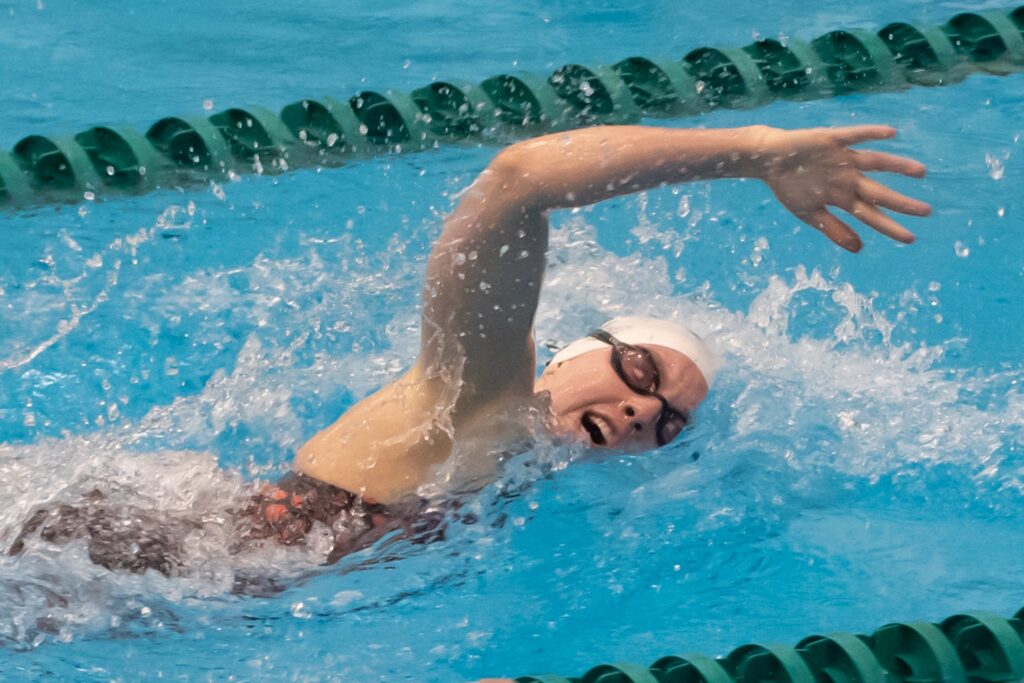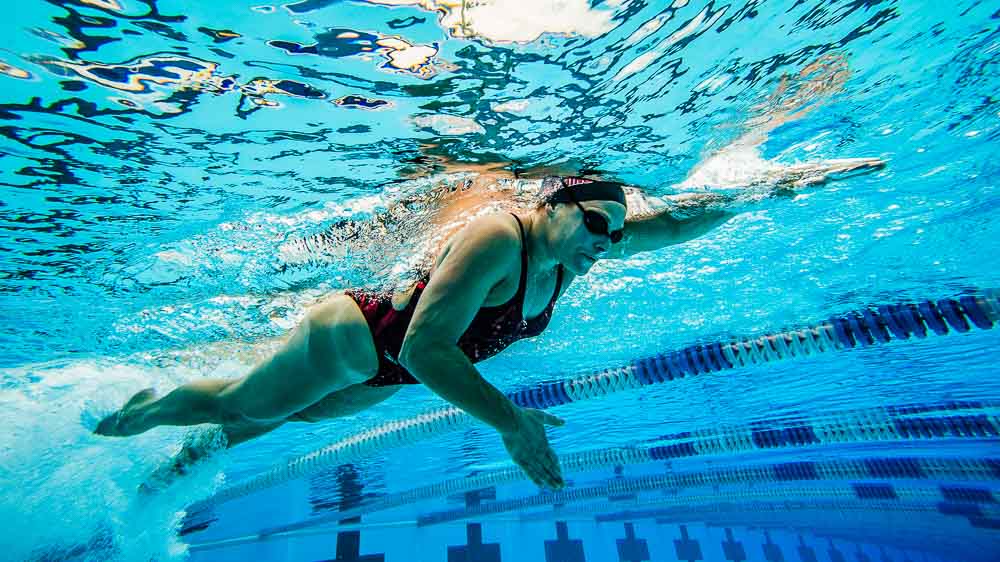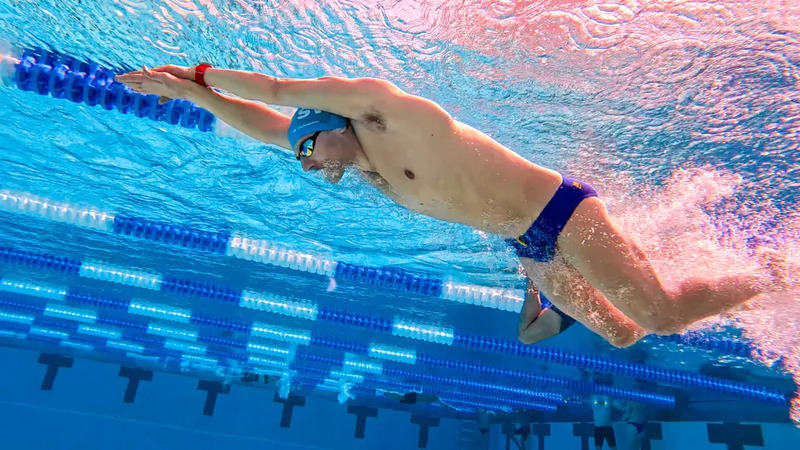Breathing effectively while swimming is not just about getting enough air; it’s about integrating breath with movement to create a seamless and efficient swimming technique. Whether you’re a beginner or an advanced swimmer, understanding and practicing the right breathing drills can significantly enhance your performance in the water. This article delves into the essentials of freestyle breathing, offering a series of drills and techniques designed to improve your breathing timing, stroke efficiency, and overall swim technique, while also emphasizing the importance of safety and the recognition of drowning signs.
Key Takeaways
- Resonance frequency breathing and the 4-7-8 technique are effective methods for swimmers to enhance relaxation and breath control.
- Exhaling underwater is crucial for maintaining a relaxed state and preventing panic, which can lead to improved swim performance.
- Drills such as the catch-up, side-kick, and three-stroke challenge help swimmers synchronize their breathing with their strokes for better efficiency.
- Advanced swimmers can benefit from bilateral breathing and high-intensity interval training to boost breath endurance and stroke transitions.
- Understanding the subtle signs of drowning, including the differences between delayed and dry drowning, is essential for swimmer safety.
Mastering the Art of Breathing in Water
Understanding Resonance Frequency Breathing
Resonance frequency breathing is a game-changer for swimmers looking to find their zen in the water. By slowing down your breathing to about 3-7 breaths per minute, you’re tapping into a powerful way to activate your parasympathetic nervous system. This is the part of your body that helps you chill out and can be a real asset when you’re trying to catch some Z’s.
Here’s the scoop: you want to inhale and exhale for a count of five. It’s like a slow-motion version of breathing that not only helps you relax but also can give your cognitive performance a boost. Think clearer, swim better – it’s a win-win!
Emotional states and breathing are like two peas in a pod. When you breathe like you’re relaxed, your brain gets the memo and follows suit. So, if you’re aiming for that calm, collected vibe, make those exhales long and luxurious.
And hey, if you’re into numbers and want to see how this stacks up against other techniques, check out the 4-7-8 method. It’s another popular way to wind down, where you inhale for 4 seconds, hold for 7, and exhale for 8. Both methods are all about using your breath to unlock a state of relaxation.
The 4-7-8 Breathing Technique for Swimmers
Diving into the 4-7-8 breathing technique, it’s all about timing and control—vital for those looking to master how to breathe in freestyle swim. This method involves inhaling for 4 seconds, holding that breath for 7 seconds, and then smoothly exhaling for 8 seconds. It’s a rhythmic pattern that can help regulate your breathing in the water.
Here’s a quick rundown on how to practice the 4-7-8 technique:
- Inhale deeply through your nose for 4 seconds.
- Hold your breath for 7 seconds.
- Exhale completely through your mouth for 8 seconds.
This technique is not just about breath control; it’s a gateway to relaxation. By extending your exhales, you signal your heart rate to slow down, which in turn calms your entire body—a crucial state for swimmers aiming for efficiency and endurance.
The beauty of the 4-7-8 technique lies in its simplicity and the profound impact it can have on your swimming. It’s a tool that can transform your freestyle, making each stroke more deliberate and powerful.
Why Exhaling Underwater is Key to Relaxation
Ever wondered why you feel like a bundle of nerves before diving in? It’s all about your breath! Exhaling underwater is like hitting the chill button for your body. It’s not just about getting rid of the old air; it’s a signal to your brain that it’s time to unwind. When you let that air out, you’re telling your body, ‘Hey, let’s take it down a notch.

Here’s the scoop: when you’re underwater, a long, leisurely exhale can do wonders for your state of mind. It’s like your body’s own natural stress-reliever. And guess what? This isn’t just feel-good advice; there’s science to back it up. Research links different breathing patterns to our emotions. So, by breathing out nice and slow, you’re basically giving your brain a memo to mellow out.
Exhaling properly while underwater also helps your child release tension and stress, making swimming more relaxing.
But how do you make sure you’re doing it right? Start with these simple steps:
- Inhale calmly and deeply before submerging.
- As you go underwater, let the air out in a controlled, steady stream.
- Aim to make your exhales longer than your inhales.
By focusing on these steps, you’ll not only keep your swimming smooth but also keep your cool in the pool.
Drills to Perfect Your Breathing Timing
The Catch-Up Drill for Synchronized Breathing
The catch-up drill is a classic that’s all about timing and coordination. Start by focusing on one arm at a time; as one arm completes its stroke and returns to the starting position, the other arm begins its stroke. This ‘catching up’ motion forces you to slow down and concentrate on the synchronization of your movements with your breathing.
Here’s how to nail it:
- Begin with one arm extended forward and the other at your side.
- As you pull the water with the extended arm, keep the other arm still.
- Once the stroking arm catches up to the extended arm, take a breath.
- Rotate your body to breathe, ensuring your head aligns with your spine.
- Alternate arms and repeat the process.
This drill teaches you to rotate your entire body while breathing, which is crucial for maintaining balance and support in the water. Remember, the goal isn’t speed—it’s about mastering the breath-stroke connection.
Using the Side-Kick Drill to Enhance Breathing Rhythm
Alright, let’s dive into one of the most effective freestyle drills for beginners that’s all about getting your breathing in sync with your movements. The Side-Kick Drill is a staple in the world of drills for freestyle breathing. It’s simple, yet super effective in helping you nail that breathing rhythm.

Here’s how you do it:
- Start by floating on your side with one arm extended forward and the other along your body.
- Kick steadily and turn your head to breathe on the side that’s out of the water.
- Focus on keeping your body aligned and your head still, only rotating it to breathe.
This drill is a game-changer for those struggling with timing their breaths. It’s a part of the freestyle kick drills that coaches swear by because it forces you to maintain a steady kick while managing your breaths. Plus, it’s a fantastic way to build up that lung capacity.
The key here is consistency. Practice this drill regularly, and you’ll see a marked improvement in your breathing technique, which is crucial for a smooth and efficient freestyle stroke.
Breath Control with the Three-Stroke Challenge
The Three-Stroke Challenge is a fantastic drill for those diving into freestyle for beginners. It’s all about learning to manage your breath over three strokes, which can significantly improve your overall swimming efficiency. Here’s how it works:
- Take a deep breath and swim three freestyle strokes.
- After the third stroke, perform a complete exhale underwater.
- Come up for air on the fourth stroke and repeat the cycle.
This drill teaches you to control your breathing and not rush your breaths, a common mistake among new swimmers. It’s a simple yet effective way to build lung capacity and get comfortable with the rhythm of breathing in freestyle.
The key to mastering this drill is consistency and patience. Don’t get discouraged if it feels challenging at first; with practice, you’ll find your groove and it’ll become second nature.
Remember, efficient breathing is a cornerstone of great swimming technique. By incorporating the Three-Stroke Challenge into your routine, you’re setting the foundation for a more relaxed and powerful swim.
Advanced Techniques for Competitive Swimmers
Bilateral Breathing for Balanced Stroke Efficiency
Bilateral breathing isn’t just a fancy term—it’s a game-changer for swimmers looking to level up their game. By alternating breaths between both sides, you ensure a symmetrical stroke and prevent muscle imbalances. It’s like hitting two birds with one breath!

Here’s the lowdown on how to get started:
- Start by breathing every three strokes, switching sides each time.
- Focus on maintaining a consistent rhythm, regardless of speed.
- Practice this during your warm-up laps to make it second nature.
One last thing: Some sprint triathlete athletes may choose to swim using unilateral breathing, but we’ve seen the benefits of going bilateral. It’s not just about oxygen—it’s about stability, rhythm, and giving both sides of your body the attention they deserve.
High-Intensity Interval Training (HIIT) for Breath Endurance
High-Intensity Interval Training, or HIIT, is a game-changer for swimmers looking to boost their breath endurance. This intense workout alternates between bursts of activity and fixed periods of less-intense activity or rest. It’s not just about pushing your limits; it’s about teaching your body to recover and adapt.
- Start with short sprints followed by equal or longer rest periods.
- Gradually increase the intensity and duration of the sprints.
- Focus on maintaining a consistent breathing pattern throughout.
HIIT significantly improves not only maximal oxygen uptake and minute ventilation, but also other critical factors like heart rate and blood pressure.
By incorporating HIIT into your training regimen, you’ll notice a remarkable improvement in your ability to handle high-intensity swims without gasping for air. It’s all about building that lung capacity and efficiency, so when it’s time to race, you’re ready to breathe less and swim more.
The Role of Breathing in Stroke Transitions
Transitioning between strokes in freestyle swimming is a dance of timing and breath control. For beginners, mastering this can be as crucial as the stroke itself. Freestyle swimming tips for beginners often emphasize the importance of a smooth transition to maintain momentum and conserve energy.
- Start by focusing on the kick in freestyle swimming, which sets the rhythm for your stroke and breath cycle.
- Observe how champions like Michael Phelps freestyle with seamless transitions, using their breath to power through each stroke.
- Practice the freestyle swimming steps in a sequence, integrating breathing as a part of the entire movement.
Swimming freestyle technique for beginners isn’t just about moving through the water; it’s about learning to harness your breath to create a fluid motion that carries you from one stroke to the next without interruption.
Remember, the key to efficient stroke transitions is not just in the arms or the legs, but in the way you breathe. By incorporating these elements into your practice, you’ll find your transitions becoming smoother and your overall technique improving.
Read more: Freestyle Swimming Foundations: A Beginner’s Guide to Getting Started
Safety First: Recognizing and Preventing Drowning
The Misconceptions of Drowning Signs
Drowning in real life isn’t the splashy, noisy spectacle you’ve seen on TV. It’s often silent and goes unnoticed, even by those nearby. Knowing what to look for is crucial, especially since drowning doesn’t always happen the way we expect.
- Silent Struggle: Victims may not wave or call for help, as they’re unable to catch a breath.
- Subtle Signs: Look for someone who is motionless in the water, or whose head is low with their mouth at water level.
- Unusual Behavior: A swimmer who is trying to roll over or appears to be climbing an invisible ladder could be in trouble.
Misconceptions can be dangerous. Recognizing the real signs of drowning is essential for timely intervention and can save lives.
While it’s vital to understand these signs, it’s equally important to know the difference between dry and delayed drowning. With dry drowning, the vocal cords spasm, blocking the airway, but no water enters the lungs. Delayed drowning involves water in the lungs that impairs breathing over time. Both are serious, but they present differently and require different responses.
Delayed vs. Dry Drowning: What Swimmers Need to Know
Distinguishing between delayed drowning and dry drowning is crucial for swimmer safety. With dry drowning, water triggers a spasm in the vocal cords, blocking the airways without water entering the lungs. In contrast, delayed drowning involves water actually reaching the lungs, potentially causing issues hours after exiting the water.
While both conditions are serious, they are relatively rare, accounting for just 1% to 2% of all drowning incidents. It’s vital to recognize the subtle signs that may indicate a problem.
Here’s what to watch for post-swim:
- Persistent coughing or difficulty breathing
- Extreme fatigue or sudden changes in behavior
- Chest pain or discomfort
Understanding these differences and symptoms can be life-saving. Remember, drowning doesn’t always look dramatic; it can be silent and quick, often occurring even under supervision.
Breathing Strategies to Stay Calm in Emergencies
When you’re caught in a tense situation in the water, your breathing can be your anchor. Slowing down your breath can signal your brain to relax, which is crucial during emergencies. This isn’t just about taking deep breaths; it’s about creating a rhythm that keeps you calm and focused.
- Inhale slowly for a count of five.
- Hold your breath for a moment.
- Exhale slowly, extending the breath longer than the inhale.
This pattern of breathing helps activate the parasympathetic nervous system, which is your body’s natural relaxant. It’s a technique that can be practiced and perfected over time, so it becomes second nature when you need it most.
In the midst of panic, your breath is a powerful tool to regain control. Practice this technique regularly to ensure it comes naturally during high-stress moments.
Drowning is a silent disaster that can strike unexpectedly, but with the right knowledge and skills, it can be prevented. Our mission at Swim Time Log is to empower individuals and communities with essential swimming techniques and water safety education. We invite you to visit our website and explore our comprehensive Knowledge Hub, where you can learn more about preventing drowning and ensuring safety for you and your loved ones. Take the first step towards a safer future by clicking on the link below and join us in the fight against accidental drownings.
Conclusion
Alright, water warriors, we’ve dived deep into the essentials of freestyle breathing and explored a variety of drills to level up your swim technique. Remember, whether you’re a beginner getting comfy with the water or an advanced swimmer fine-tuning your strokes, the key is to keep practicing. Embrace the process, and don’t forget to pay attention to your breathing—it’s not just about how fast you can go, but also how efficiently you can glide through the water. So, take a deep breath, and let’s make some waves! Until next time, keep swimming and stay buoyant!
Read more: Mastering the Stroke: An In-depth Guide to Freestyle Drills
AUTHOR
Sang Nguyen
Sang Nguyen is a former national swimmer for Vietnam who has transitioned into coaching. With a passion for fostering a healthy swimming community and connecting like-minded individuals,......Read More
BLOG
Maybe You Are Interested
Good Swim Meet Snacks: What to Eat for Optimal Performance
Good nutrition is crucial for swimmers to maintain energy, recover quickly, and perform at their...
Read More...Optimizing Your Performance: The Best Diet for Swimming Training
Optimizing your performance in swimming is not just about rigorous training; it’s equally crucial to...
Read More...Achieve Peak Performance with This Diet Chart for Swimmers
Whether you’re a novice or an expert swimmer, understanding the right diet is crucial for...
Read More...Eating Like a Champion: Exploring the Diet of Michael Phelps
Michael Phelps, renowned for his Olympic triumphs, has a diet as extraordinary as his swimming...
Read More...Muscle Gain for Swimmers: Tailoring Your Diet for Strength
Swimming is a demanding sport that requires a tailored approach to nutrition to support muscle...
Read More...A Comprehensive Diet Plan To Gain Weight For Swimmers
Swimming is a demanding sport that requires meticulous attention to nutritional needs to optimize performance,...
Read More...